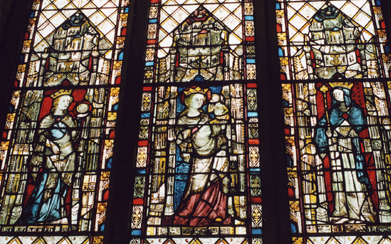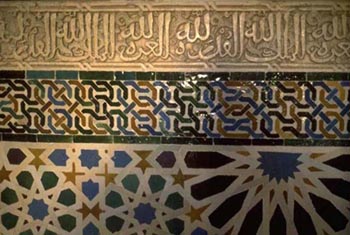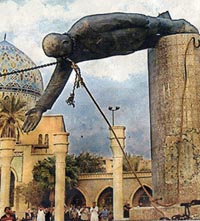Virginia Raguin, Professor
of Art History
Elizabeth Gittings,
Lecturer in Art History
INTRODUCTION
TO VISUAL ARTS
FALL 2003
 |
LOVE
THEM
OR HATE
THEM
THE POWER OF
THE IMAGE IN ART
LATE-MEDIEVAL
SAINTS IN OXFORD
|
This course will examine
the question of images throughout the centuries looking at vivid
examples of image worship, veneration, abhorrence, and destruction
from the birth of Christianity, through the rise of Islam, Protestant
Reformation to the present day and the toppling of statues in Iraq.
|
THE
ALHAMBRA
SPAIN
MUSLIM
MEANING AND SPIRITUALITY
AND
ABSENCE
OF
IMAGERY
|
 |
The course
will be structured to include a series of topics addressed by short
papers. At least two required evening meetings will present special
guest lectures and/or panel discussions. For most topics, students
will exchange papers for comments and/or read their papers in class.
We envision a high degree of interaction and exchange of ideas.
SECTION
1
Text and Image within the Christian Tradition
,(including Old Testament as well as New).
Lateran
Passion Sarcophagus, Early Christian liberation images in catacombs.
San Vitale, Anglo-Saxon Poem: Dream
of the Rood
Stories of the Life of Christ: Annunciation in the Merode
Altarpiece, 1425, Nativity in Hugo Van der Goes, Portinari
Altarpiece, 1474-76; and Death in van der Weyden, Deposition
Louvain, Belgium,
Assignment
Worcester Art Museum: Select a work of art relating a biblical event.
Find the appropriate text passage in Scripture. Look at the image
- what is the same; what is different? How has the visual structure
constructed meaning - and is it the same as the text?
Possibilities
1. Edward Hicks, The
Peaceable Kingdom (1934.65) oil on canvas, America ca. 1833
(Isaiah 11: 6-9)
2. Benjamin West, Pharaoh
and His Host Lost in the Red Sea (1960.18) 1792 and after
1800, artist was born in Springfield PA painting made in England
(Exodus 14)
3. Washington Allston, Christ
Healing the Sick (1920.91) 1813 America (Matthew 4: 24;
8:1-18; 9; Mark 2, 3 , 7; Luke 4: 38-20)
4. Last
Supper and Agony in the Garden (1924.24), fresco; Spoleto
Italy ca. 1300 century (Matthew 26: 14-45; Luke 22: 11-46)
5. Barnardo Strozzi, Calling
of Saint Matthew (Italian Baroque)
(Matthew 9: 9-13; Mark 2: 14-17)
6. Crucifixion
with the Virgin and St. John
(1934.26 a,b,c) Oviedo (Asturias) Spain, 13th century.
7. Quentin Massys, The
Rest on the Flight to Egypt (1937.4) Lowlands (Flanders),
oil on panel, ca. 1509-13 (Matthew 2: 13-23)
8. Alonso Cano, Christ
Bearing the Cross (1920.95) Spain, 1635-37. (pupil of Pacheco)
(Matthew 27; Mark 15; Luke: 23; John: 19)
SECTION
2 Absence of the Image
Space as Spiritual - Architecture: the structure of the Mosque:
example Cordoba
Cistercian monastic art of the 12th century
Transfiguration of Christ - Apse
of San Apollinare in Classe
Celtic Art: Tapestry Pages, Interlace, Books
of Kells, Book of Durro
Image Absent in Modern Art: Piet Mondrian; Jackson Pollock, Mark
Rothko, Maya
Lin: Vietnam
Memorial etc. See film made by Maya Lin, which included her
Martin Luther King memorial fountain
Lecture
and Discussion: The Non-figural Arts and Islamic Spirituality
Ibrahim Kalin, Prof. of Islamic Studies, College of the Holy Cross
7 PM, Tuesday, Sept. 30, Rehm Library, Smith Hall.
To what
extent is it possible to understand a material object such as a
non-figural work of art in an immaterial, spiritual sense? One of
the richest of all non-figural visual traditions, the arts of the
Islamic world reflect, express, and reinforce a variety of mystical
and aesthetic beliefs through motifs such as calligraphy and repetitive
geometric patterns. How does one respond to such non-representational
motifs--at the core of Islamic art--in an intelligible medium such
as language? How do such motifs relate ideas of the infinity of
God within visual experience, in terms of color, texture, shape,
and space? How do Islamic non-representational themes work in the
context of a medium such as architecture that unfolds in time?
SECTION
3 Destruction of the Image
Byzantine Iconoclasts and the meaning of the Icon; the Chuldoff
Psalter image of iconoclasts whitewashing an icon.
Protestant
Destruction of Catholic Images:
Example of pre-reformation altarpieces, Mattias Grünewald,
Isenheim
Altarpiece 1510 German
Reformers: Martin
Luther 1540s? by Lucas
Cranach also Johann
I and Frederick II the Wise, Electors of Saxony, 1533. Interior
of Protestant
churches in the Low Countries: white walls, absence of imagery
in paintings by Pieter Saenredam, Choir
of Saint Bavo's Church at Haarlem, 1660, Worcester Art Museum,
English Reformation
Iconoclasts; Hans Holbein the Younger Henry
VIII, 1540 and family.
Protestant German Art: Four
Apostles and details
by Albrecht Dürer, The importance of John and Paul as preachers
eclipsing the Roman saints of Peter and Mark. John sanguine, Paul
melancholic, Peter phlegmatic, Marc choleric. See four humors in
animals in Dürer's Adam
and Eve, engraving of 1504, rabbit sanguine, elk melancholic,
ox phlegmatic, cat choleric.
Counter
Reformation Cult of Images:
Life of Christ, Saints, Papacy and Miracles
Rubens - Raising
of the Cross 1610 (originally Church of St. Walpurga, Antwerp)
and Descent
from the Cross 1612-14 Antwerp Cathedral,
Baciccio (Giovani Battista Gaulli), Vision
of Saint Ignatius at La Storta, about 1684-85 Worcester
Art Museum
Bernini The
Ecstasy of Saint Theresa 1647-52 Cappella Cornaro, Santa
Maria della Vittoria, Rome
The
Throne of Saint Peter 1657-66 San Pietro, Rome
Rosso Fiorentino,
Dead Christ with Angels, 1525-26, Museum of Fine
Arts, Boston
Caravaggio, The
Entombment, 1602-03 Pinacoteca, Vatican
Story
of St. Matthew - 1599-1600 paintings of the Contarelli Chapel,
San Luigi dei Francesi, Rome ,
Imagery
of the Age of Enlightenment: Person
freedom and individual tenderness
Watteau, The
Embarkation for Cythera, 1717 , Musée du Louvre,
Paris
Fragonard, 1771-73 Progress of Love, Confession
of Love.
The intimate portrait: Thomas Gainsborough, Portrait
of the Artist's Daughters, about 1763-64, Worcester
Art Museum
Lecture:
Veronique Plesch, Associate Professor and Chair of the Department
of Art, Colby College, GRAFFITI and MEMORY
Oct.
30: 7 PM
Stein 129. Oratory chapel of Saint Sebastian at Arborio, a small
town in Northern Italy about 35 miles west of Milan: detail of saints,
St. Sebastian, and detail of graffiti.
Nazi Campaign
against
Entartete Kunst (Degenerate Art) Works condemned and linked
to racial impurity and mental instability: Kathe
Kollwitz; Franz Marc; Marc Rothko, Paula Moderson-Becker, Ludwig
Kirchner, Emil Nolde, etc. (exhibition 1993, Los Angels Museum of
Art Degenerate Art: The Fate of the Avant-Garde in Nazi-Germany.
Taliban destruction of monumental rock-cut statues of Buddha in
Afghanistan: Finbarr Barry Flood, "Between Cult and Culture:
Bamiyan, Islamic Iconoclasm, and the Museum, " Art Bulletin
84 (2002): 641-659.
SECTION 4 Images I Love, Fear, Hate
What are contemporary idols - i.e. images that are important to
us? Why are we attracted to an image - a portrait, a religious image,
a painting? How do the printed news, television, Internet, or movies,
impact our lives?
Coverage of 9/11?
Gulf War? Pornographic controversy over contemporary art?
Final Project:: Student papers
from which a 5-6 minute (?) oral presentation is made in the
last three classes. All students write reactions to the presentation,
ranking presentations according to clarity of ideas and persuasiveness
of argument. |
 |
Bernini,
sensusality and violence
Apollo
and Daphne
Rape
of Persephone
Reaction
to atrocity: Picasso, Guernica
Photographic essays; documentary photography. Vietnam war; Television
coverage
Twentieth century:
Image Absent: Piet Mondrian; Jackson
Pollock, Marc Rothko, Robert Smithson
Image
Present: Andy Warhol,
Willem DeKooning, Audrey Flack, Judy Chicago, Cindy Sherman